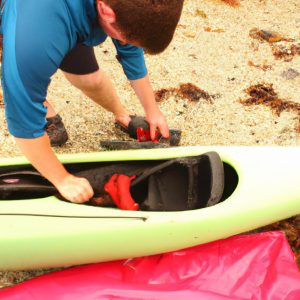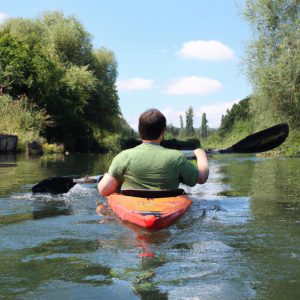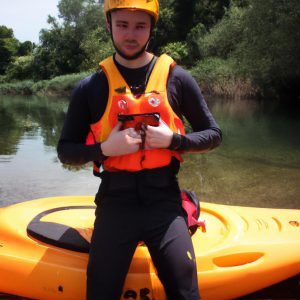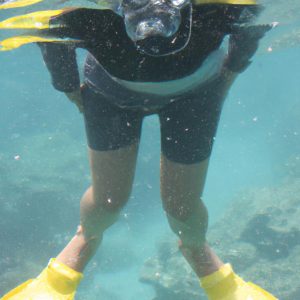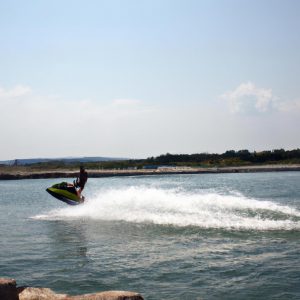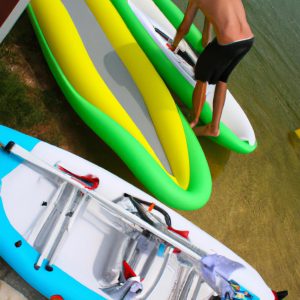Kayak Fishing Tips: Essential Advice for Water Sports Enthusiasts
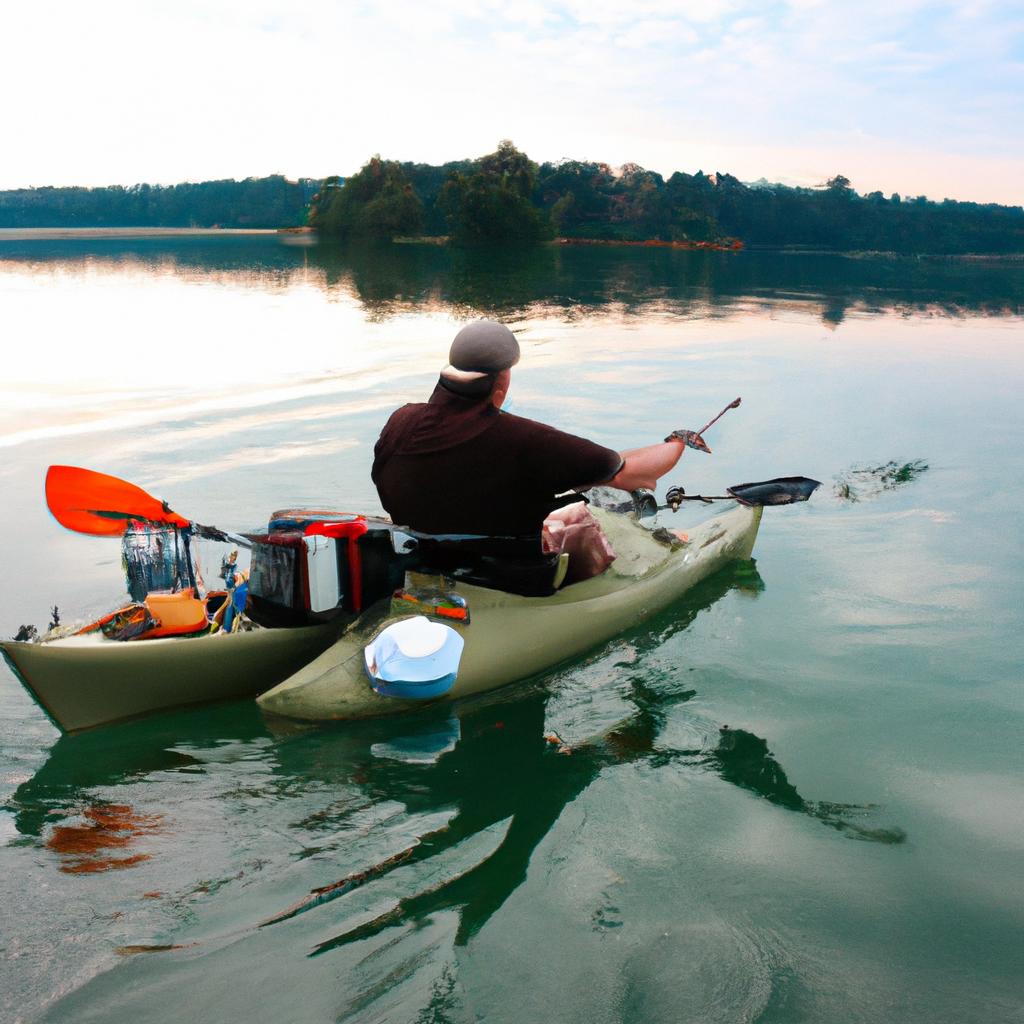
Kayak fishing has become an increasingly popular activity among water sports enthusiasts. The combination of the tranquility of being on the water and the thrill of catching fish creates a unique experience that appeals to many individuals. Take, for example, John, an avid kayaker who recently discovered his passion for fishing while exploring local lakes in his kayak. He quickly realized that there is much more to successful kayak fishing than simply paddling out into the water with a rod and reel.
In order to maximize your chances of success and enhance your overall experience as a kayak angler, it is essential to have a solid understanding of various tips and techniques specific to this sport. This article aims to provide valuable advice for water sports enthusiasts looking to venture into the world of kayak fishing. By following these guidelines, you will be equipped with the knowledge needed to navigate through different challenges such as selecting the right gear, mastering proper casting techniques, and maximizing productivity on the water. Whether you are a beginner or an experienced kayaker, incorporating these essential tips into your practice will undoubtedly contribute to your enjoyment and success in this exhilarating hobby.
Choosing the Right Kayak for Fishing
Imagine you are an avid water sports enthusiast who is eager to explore the exciting world of kayak fishing. To ensure a successful and enjoyable experience, it is crucial to choose the right kayak that caters specifically to your fishing needs. With various options available in the market, making this decision may seem overwhelming at first. However, by considering key factors such as stability, maneuverability, storage capacity, and weight capacity, you can narrow down your choices and find the perfect kayak for your angling adventures.
Stability plays a significant role in ensuring a comfortable and secure fishing experience on a kayak. Sit-on-top kayaks tend to offer better stability compared to sit-inside models due to their wider hull designs. This feature allows anglers to maintain balance while casting lines or reeling in fish without worrying about tipping over. In contrast, sit-inside kayaks provide more protection against splashes and harsh weather conditions but sacrifice some stability.
Maneuverability also deserves careful consideration when selecting a fishing kayak. A shorter kayak with a narrower width tends to be more responsive and easier to navigate through tight spaces like narrow rivers or dense vegetation areas where fish often hide. On the other hand, longer kayaks generally track straighter and perform better in open waters such as lakes or coastal areas.
Storage capacity is another essential aspect to evaluate when choosing a fishing kayak. Adequate storage ensures that all your gear—such as rods, tackle boxes, coolers, and personal belongings—can be securely stored onboard while leaving enough space for movement during your expedition. Some kayaks even have built-in rod holders or additional compartments designed explicitly for organizing fishing equipment.
Weight capacity refers to the maximum load capacity of a kayak without compromising its performance on water. It is vital to consider not only your own weight but also any additional equipment or accessories you plan to bring along on your fishing trips. Overloading your kayak can negatively impact its stability, maneuverability, and overall safety.
To summarize, choosing the right kayak for fishing entails considering factors such as stability, maneuverability, storage capacity, and weight capacity. By evaluating these aspects and finding a balance that aligns with your preferences and fishing style, you can make an informed decision when purchasing a kayak tailored to your specific needs.
Essential Gear for Kayak Fishing
Having chosen the right kayak for fishing, it is now crucial to ensure you have all the essential gear needed for a successful and enjoyable kayak fishing experience. Equipping yourself with the appropriate tools will not only enhance your performance but also contribute to your safety on the water.
Gear Checklist:
To make sure you are well-prepared before hitting the water, here is a checklist of essential gear for kayak fishing:
- Paddle: A durable and lightweight paddle that suits your kayaking style is vital. Look for one made from materials like fiberglass or carbon fiber for better efficiency and comfort.
- Life Jacket: Your personal floatation device (PFD) should always be worn while kayaking. Opt for an inflatable or foam-filled life jacket designed specifically for water sports activities.
- Fishing Rod Holder: Installing rod holders onto your kayak allows you to keep your hands free while paddling or reeling in fish. This convenient accessory ensures easy access to your rods whenever needed.
- Tackle Storage: Organizing your tackle efficiently can save time and frustration during fishing trips. Consider using waterproof bags or containers with dividers to keep everything neatly arranged and protected from moisture.
As you gather your gear, remember these key points to maximize both functionality and enjoyment:
- Stay organized by labeling storage compartments.
- Invest in high-quality equipment that will last longer.
- Research different brands and read customer reviews before purchasing.
- Carry spare parts such as extra hooks, lines, and sinkers in case of emergencies.
Table – Essential Gear Comparison:
| Gear | Pros | Cons |
|---|---|---|
| Kayak | Maneuverability | Limited storage capacity |
| Paddle | Lightweight | Potential fatigue |
| PFD | Safety | Restricted movement |
| Rod Holder | Hands-free operation | Space limitation |
By equipping yourself with the necessary gear, you are setting yourself up for a successful kayak fishing adventure. Remember to always prioritize safety and invest in quality equipment that suits your needs.
Now that you have all the essential gear, it’s time to focus on ensuring your safety during kayak fishing expeditions. Let’s explore some crucial safety tips to keep in mind while out on the water.
Safety Tips for Kayak Fishing
As we delve into the world of kayak fishing, it is crucial to equip ourselves with the essential gear that will enhance our experience on the water. By investing in quality equipment, anglers can maximize their chances of success and safety while out on their kayaks.
Example:
Consider a scenario where John, an avid angler, sets out on his first kayak fishing expedition without proper gear. He quickly realizes that he lacks important tools needed for a successful outing – no rod holders to secure his fishing rods, no anchor system to keep him in position, and no personal flotation device (PFD) for added safety. Frustrated by this oversight, John returns home empty-handed and disappointed. To avoid such a situation, let’s explore the indispensable gear every kayak angler should have.
Gear Checklist:
To ensure you are fully prepared for your next kayak fishing adventure, make sure you have the following essentials:
- Fishing Rod Holders: These attachments allow you to secure your fishing rods securely while paddling or when waiting for a bite.
- Anchor System: An anchor system helps maintain your desired position amidst shifting currents or windy conditions.
- Personal Flotation Device (PFD): Wearing a PFD not only ensures your safety but also keeps you legal according to boating regulations.
- Tackle Storage Solutions: Organize your lures, baits, hooks, and other tackle items efficiently using waterproof containers or specialized tackle boxes.
Table showcasing different types of tackle storage solutions:
| Type | Description |
|---|---|
| Waterproof Containers | Durable plastic cases designed to protect tackle |
| Soft Tackle Bags | Versatile bags with multiple pockets and compartments |
| Hard Tackle Boxes | Sturdy boxes with adjustable dividers |
Investing in these fundamental pieces of gear will significantly improve your kayak fishing experience. With the right equipment, you can focus more on the art of angling and less on struggling with inadequate tools.
” By mastering these strategies, you’ll be well-prepared to tackle any fishing scenario from your trusty kayak.
Techniques for Successful Kayak Fishing
Techniques for Successful Kayak Fishing
Imagine this scenario: You’re out on the water, surrounded by nature’s tranquility, waiting patiently for that perfect catch. As a kayak fishing enthusiast, mastering certain techniques can significantly enhance your chances of success. In this section, we will explore three key strategies to help you improve your kayak fishing skills.
First and foremost, it is crucial to select the right bait or lure for each fishing expedition. Different fish species have varying preferences when it comes to food, so tailoring your choice accordingly can make all the difference. For instance, if you are targeting largemouth bass in freshwater lakes, using plastic worms or jigs would be more effective compared to live bait such as minnows. By understanding the feeding habits of your desired catch and selecting appropriate baits or lures, you increase your likelihood of enticing strikes.
Secondly, being mindful of your positioning while kayak fishing is essential. Proper boat control allows you to navigate stealthily through the water without spooking nearby fish. One technique often employed is anchoring strategically in areas with high fish activity. This ensures that you stay within casting range and maximize your chances of hooking a fish successfully. Additionally, utilizing tide charts and studying weather patterns enables you to predict where fish might congregate during specific times of day or year.
Lastly, honing your casting accuracy can greatly impact your productivity on the water. Practice makes perfect – develop muscle memory by consistently working on precise casts over time. By effectively placing your bait or lure near structures like docks or vegetation beds where fish tend to hide, you amplify opportunities for bites. Consider experimenting with different casting styles like flipping or pitching based on target location and environmental conditions.
To further fuel your passion for this exhilarating sport, here are some insights into what motivates fellow kayak anglers:
- The sense of freedom and connection with nature
- The thrill of challenging oneself against unpredictable elements
- The satisfaction of catching fish using one’s own skills and knowledge
- The opportunity to explore lesser-known, secluded fishing spots
Furthermore, take a look at the table below which highlights some popular kayak fishing accessories:
| Accessory | Description | Benefits |
|---|---|---|
| Fish Finder | Electronic device that locates fish underwater | Helps identify productive fishing areas |
| Paddle Leash | Keeps paddle secure while not in use | Prevents accidental loss during active fishing |
| Rod Holder | Holds fishing rod securely on the kayak | Allows for hands-free operation |
| Dry Bag | Waterproof bag for storing valuables | Protects personal belongings from water damage |
By incorporating these techniques into your approach and understanding what drives others who share this passion, you are well-equipped to embark on successful kayak fishing adventures.
Best Locations for Kayak Fishing
Now let’s turn our attention to exploring some of the most sought-after destinations for kayak fishing enthusiasts worldwide.
Best Locations for Kayak Fishing
Section H2: Best Locations for Kayak Fishing
In the previous section, we discussed various techniques that are essential for successful kayak fishing. Now, let’s explore some of the best locations where water sports enthusiasts can indulge in this thrilling activity.
Imagine you find yourself in a serene lake surrounded by lush greenery and breathtaking mountain views. This picturesque setting is the perfect spot to cast your line and enjoy some quality time on your kayak. Such tranquil freshwater lakes offer an abundance of fish species like bass, trout, pike, or walleye, making them ideal destinations for kayak fishing enthusiasts.
When it comes to coastal areas, imagine paddling through crystal-clear waters along a pristine shoreline. Coastal regions provide kayakers with endless opportunities to catch gamefish such as redfish, snook, tarpon, or flounder. The combination of saltwater currents and diverse marine ecosystems bring forth exciting challenges and rewards for those who venture into these dynamic environments.
To engage our audience emotionally, here are four reasons why these locations will leave you awe-inspired:
- Immerse yourself in nature’s beauty while enjoying peaceful solitude.
- Experience the thrill of catching trophy-sized fish amidst stunning surroundings.
- Connect with fellow water sports enthusiasts who share your passion.
- Create lasting memories as you navigate through different terrains and encounter unique wildlife.
Additionally, below is a table highlighting key features of these prime kayak fishing locations:
| Location | Fish Species | Scenic Beauty | Accessibility |
|---|---|---|---|
| Freshwater Lakes | Bass, Trout | Lush Greenery | Easily reachable |
| Coastal Areas | Redfish | Pristine Shoreline | Moderate access |
As we conclude this section on the best locations for kayak fishing, it becomes evident that both freshwater lakes and coastal areas hold immense appeal due to their diverse offerings. These natural settings not only challenge anglers but also provide an opportunity to connect with nature on a deeper level.
Now let’s delve into the crucial Environmental Considerations for Kayak Fishing.
Environmental Considerations for Kayak Fishing
When venturing out for a kayak fishing expedition, it is crucial to consider the environmental factors that can impact your experience. Take, for instance, the case of John, an enthusiastic angler who decided to visit his favorite fishing spot on a calm summer morning. As he paddled his kayak towards the open water, he noticed a sudden change in weather conditions. Dark clouds started rolling in and strong gusts of wind swept across the lake. Unprepared for this unexpected turn of events, John found himself struggling against the elements and had to cut short his fishing trip.
To ensure a safe and enjoyable kayaking and fishing experience, here are some important environmental considerations:
-
Weather Conditions:
- Always check weather forecasts before heading out.
- Be aware of changing conditions during your trip.
- Carry appropriate gear like rain jackets or sun hats based on the forecast.
- Avoid going out if severe weather warnings are issued.
-
Water Quality:
- Research local water quality reports from reliable sources.
- Stay updated about any potential issues such as pollution or harmful algal blooms.
- Follow guidelines for catch-and-release practices to minimize harm to fish populations.
-
Wildlife Interaction:
- Respect wildlife by keeping distance and not disturbing their habitats.
- Avoid feeding animals as it disrupts natural behaviors and diets.
- Dispose of trash properly to prevent attracting wildlife to human areas.
-
Conservation Practices:
| Conservation Practices | Description |
|---|---|
| Practice Catch-and-Release | Return caught fish unharmed back into the water |
| Use Biodegradable Baits | Choose environmentally friendly bait options |
| Minimize Noise Pollution | Keep noise levels low to avoid disturbing aquatic life |
Incorporating these environmental considerations will not only enhance your own safety but also contribute to sustainable fishing practices. By being mindful of weather conditions, water quality, wildlife interaction, and conservation efforts, you can help preserve the natural beauty of our aquatic environments for future generations to enjoy.
Remember that a responsible angler is not only one who catches fish but also respects and protects the delicate balance of ecosystems. So equip yourself with knowledge, follow best practices, and be an advocate for sustainable kayak fishing.

